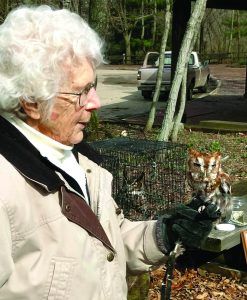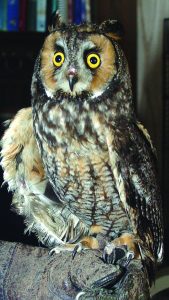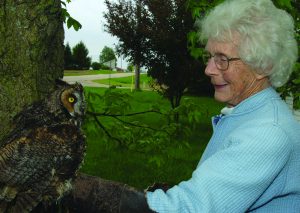Longtime wildlife care-giver still gives a hoot
Elise Zwicky for Chronicle Media — May 10, 2017
Wildlife rehabilitator Marge Bjorklund talks to Forrest, a rare long-eared owl she is caring for at her place in Peoria County. The injured owl was found in Elmwood and will never fly again. (Photo by Elise Zwicky / for Chronicle Media)
Bird watcher Leanna Kijanowski needed eagle-eye vision to spot the camouflaged long-eared owl sitting at the base of a maple tree in her Elmwood yard last winter.
“I knew we were looking at something really really cool,” she said in a recent phone interview.
“We could tell right away the bird was injured,” her husband, Jerry, added. “When I went on the porch it was about 10-to-12 feet away, and it noticed me right away. It spread its wings, and you could tell one of the wings was not the same as the other.”
The long-eared owl is rare enough in downstate Illinois that longtime wildlife rehabilitation expert Marge Bjorklund wasn’t immediately convinced that’s what it was when she got the call.
“In 37 years I’ve only ever received one other long-eared owl,” Bjorklund said.
This owl, which Bjorklund has named Forrest, will never fly again but he’s thriving under her care and has become part of an educational program she presents twice monthly at Wildlife Prairie Park.
The petite octogenarian has a permit through the U.S. Fish and

A long-eared owl that was found injured in Elmwood and will never be able to fly again is now part of wildlife rehabilitator Marge Bjorklund’s educational permit. Bjorklund presents a program about her birds—including owls, kestrels and a duck—twice monthly at Wildlife Prairie Park. (Photo by Elise Zwicky / for Chronicle Media)
Wildlife Service in Bloomington, Minn., to keep and care for more than a dozen birds for educational purposes.
Prior to getting permission to add Forrest to her permit, Bjorklund sent the agency a thick envelope full of information, including a veterinarian’s report, her plans on how to house and feed the owl and information on her efforts to teach the public about birds of prey.
“I heard back from them more quickly than usual,” Bjorklund said about the government agency. “Usually they make it very difficult because they don’t want people filling up their houses with crippled birds as pets. They want to make sure they do the right thing for the bird.”
Forrest joins Bjorklund’s flock of other handicapped or non-releasable birds, including a 19-year-old, four-ounce screech owl named Twig who was found as a fledgling on the sidewalk at the Peoria Metro Center.
She also has an endangered barn owl, a great-horned owl, a barred owl, a red-tailed hawk, two kestrels, a duck and a 17-year-old crow named Corvus.
“We’re all aging together,” Bjorklund said with a chuckle. “Corvus bows and says hello. He comes to the front of the cage and puts his head down, and that’s my signal that I’m supposed to pet him.”
After being contacted by the Kijanowskis on Dec. 31 when they discovered the long-eared owl, Bjorklund arranged for Peoria County Animal Protection Services to catch it and bring it to her place in Peoria County.
Bjorklund took the owl to a local veterinarian, who determined through X-rays that the elbow joint in the wing is dislocated and would never heal properly.
“The owl would have very quickly perished if they hadn’t found him because  he would be unable to hunt without being able to fly,” Bjorklund said. “We have no idea how it got injured. I’m guessing it may have been bumped by a car.”
he would be unable to hunt without being able to fly,” Bjorklund said. “We have no idea how it got injured. I’m guessing it may have been bumped by a car.”
Bjorklund is uncertain how old the owl is, although she knows it’s an adult.
“It’s very striking looking and it does look exactly like the trunk of a tree. They’re called tree huggers because they’ll actually put one wing around the trunk of the tree. The eyes are yellow, and they stare right through you. I tell people: you better go confess your sins because this owl can see them,” she quipped.
The long-eared owl was on the endangered species list in Illinois at one time but isn’t currently. According to the Illinois Raptor Center’s website, the owl’s “habit of roosting in the deepest, darkest part of wooded areas mean it is rarely seen and hard to find.” They also tend to stretch their bodies vertically to blend in with the tree.
The website states that long-eared owls have declined in Illinois over the years, likely due to habitat loss. However, an article last February in the Chicago Tribune reported that an unusually high number of long-eared owls were recorded last winter around Chicago by birders in birding databases for unknown reasons. The birds typically breed in northern Wisconsin, northern Michigan, Minnesota and Canada.
Bjorklund said Forrest, who only weighs about a pound, has been eating three or four mice a day. She orders frozen mice for her birds from a company in Indiana so she knows they’re free of poison and bacteria.
Bjorklund shows the birds at Wildlife Prairie Park from 10 a.m to 12 p.m. the first and third Saturday of each month. She volunteers her time but puts out a donation jar, with any funds going to help purchase food for the birds. Although she’s required to be licensed, Bjorklund receives no pay or outside funding to care for injured wildlife.
“I’m very proud of the birds, and I enjoy sharing them. Maybe I can inspire a few people to be a little more tolerant of the wildlife that lives with us,” Bjorklund said.
The Kijanowskis happened to catch Bjorklund at Wildlife Prairie Park recently and were thrilled to see the long-eared owl again.
“I was hoping it would be able to be released, but Marge is a great educator and I’m behind anything that will encourage conservation,” Leanna Kijanowski said.







